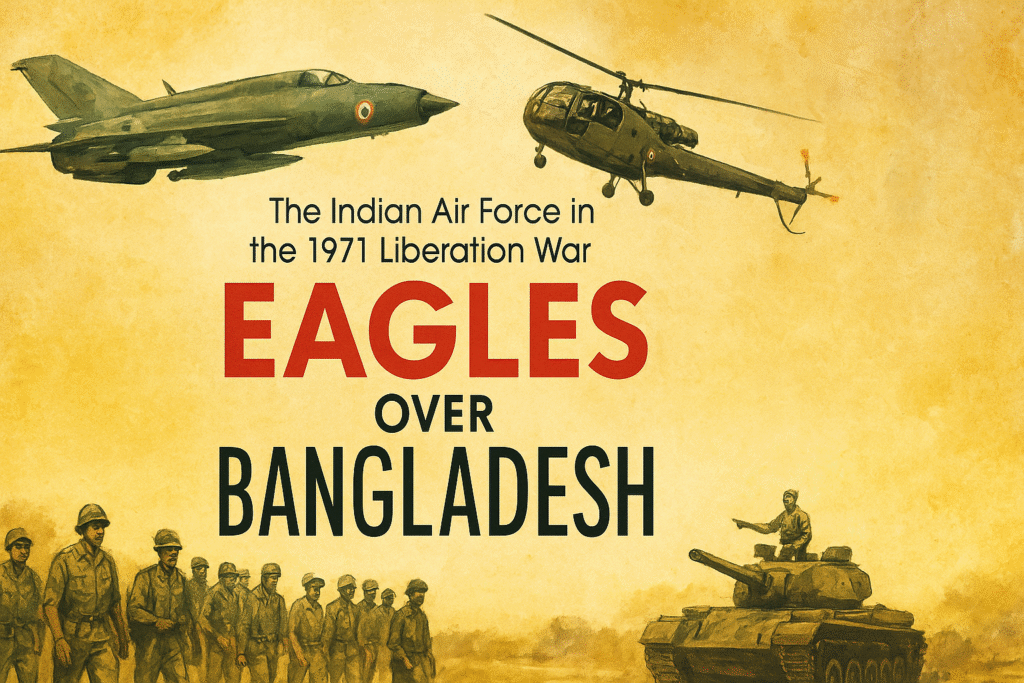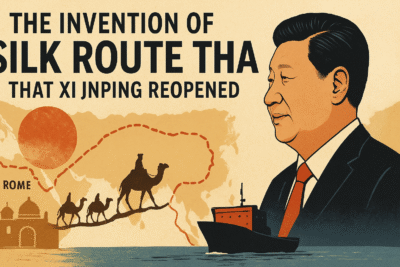
In a year when India’s skies have again thundered with the echoes of airpower — thanks to the headline-grabbing “Operation Sindoor” — a book about the Indian Air Force’s defining campaign half a century ago feels more urgent than ever. Eagles Over Bangladesh: The Indian Air Force in the 1971 Liberation War is more than old war stories; it’s a vivid, rigorously sourced look at the last time air dominance on the subcontinent rapidly changed the course of history.
If recent headlines left you searching for a deeper context behind the IAF’s modern spectacles, this narrative, shaped by first-person pilot accounts and sharp operational analysis, offers a timely window into how focused air campaigns shape war — and peace.
Why this book, why now
With public interest in India–Pakistan warfare surging again after Operation Sindoor—India’s May 2025 stand-off strikes and air operations—this book offers a clear, meticulously researched window into the last campaign where airpower decisively shaped the political endgame in the subcontinent: the 1971 Eastern Front.
Written by PVS Jagan Mohan and Samir Chopra, Eagles Over Bangladesh reconstructs how the Indian Air Force (IAF) gained air superiority within days, isolated the battlespace, and enabled a rapid ground thrust to Dacca (Dhaka). It’s both a narrative history and a professional study—ideal for readers trying to make sense of Sindoor through the lens of an earlier, shorter, and strategically decisive war.
What the book covers (and how well)
Campaign architecture, not just dogfights. The authors chart the air war from the first night strikes on Dacca’s airfields to sustained interdiction that choked Pakistani logistics and freedom of movement in East Pakistan. You get a feel for how attrition, tempo, and target selection collapsed the opponent’s decision space—less Top Gun, more operations research in plain English.
First-person texture. Pilot recollections and unit diaries—curated rather than dumped—animate everything from low-level strike runs to helicopter-borne river crossings (the famous “Meghna heli-bridge”) and the Tangail para-drop. The anecdotes don’t overpower the analysis; they humanize it.
Maps, orders of battle, and chronology. It’s unusually strong on reference detail without ever reading like a spreadsheet. If you’re mapping sorties to outcomes, this is gold.
Production values. The HarperCollins India edition is cleanly laid out; the writing is economical and avoids hagiography. For a campaign that ended in under two weeks, the pacing feels taut rather than rushed.
Three takeaways that speak directly to “Sindoor”
- Speed to air dominance matters more than platform glamour. In 1971, early neutralization of enemy runways and aircraft made the ground fight almost foregone. Sindoor’s first hours similarly emphasized pre-planned, stand-off strikes and time-sensitive targeting—now with cruise missiles and loitering munitions, a technological evolution of the same logic: win the air, shape the ground.
- Jointness is the real asymmetric advantage. The book shows airpower as the hinge for para-drops, heli-lifts, and riverine crossings; the whole was greater than the parts. Post-Sindoor briefings and official narratives hammered the same theme—“forging one force”—with tighter integration across IAF, Army, and strategic fires.
- Psychology and signaling ride on precision. In 1971, concentrated strikes on nerve-centers like Dacca produced outsized political effects. In 2025, the IAF’s long-range kill—widely reported as ~300 km—was notable not just as a rare shot, but as a message about reach, sensors, and the futility of sanctuary. Eagles Over Bangladesh helps you understand why such moments tip negotiating leverage.
Strengths
- Evidence-driven and accessible. The authors are known for archival spadework and careful vetting; the prose stays readable even when the subject is technical. For journalists and history buffs tracking Sindoor fallout, this is an antidote to hot takes.
- Operational cause-and-effect. You see how specific strike packages produced ground effects within 24–72 hours—a template that clarifies why India’s recent concept of operations leaned on synchronized, multi-axis stand-off fires.
- Human stakes. The pilot voices keep the narrative grounded—courage, fatigue, friction—without romanticizing war.
Gaps (and how to read around them)
- Eastern-front focus. By design, the book is not a complete 1971 air war history; it’s about the Bangladesh theater. Readers seeking a West-front comparison will need complementary sources.
- Technology has leaped. UAVs, networked ISR, and long-range precision strike dominate Sindoor discussions; the book predates this era. Treat it as a doctrinal ancestor, not a 1:1 playbook.
- Limited Pakistani perspective. The narrative draws most heavily on Indian and Bangladeshi sources; Pakistani operational insight is thinner, which can matter for balance.
How it deepens a Sindoor-era reading of India–Pakistan conflict
- Ends, ways, means. 1971 shows how clear political ends (liberation and surrender) enabled decisive operational design. Sindoor’s stated aims were narrower—punitive/denial strikes after the Pahalgam attack—but the means (stand-off munitions, coordinated salvos) and ways (time-boxed tempo) rhyme with 1971’s playbook of speed and paralysis.
- Escalation management. The 1971 Eastern Front was designed to localize escalation; Sindoor’s heavy use of precision at range, and its compressed timeline, reveal a modern attempt to do the same—signal capability while controlling ladder-rungs. Official releases and subsequent coverage underscore this calibrated approach.
- Narrative and morale. In both cases, early air successes shaped domestic and international narratives. The government’s public honoring of Sindoor gallantry and the amplification of precision feats reflect a continuity in how airpower is used to build strategic confidence at home.
Verdict
If you’re trying to understand why the IAF is at the center of India’s coercive diplomacy today, Eagles Over Bangladesh is essential reading. It doesn’t predict the next round, but it equips you to interpret it—showing how operational tempo, joint integration, and targeted paralysis can turn a short war into a decisive political outcome. In the shadow of Operation Sindoor, that’s exactly the lens most readers are looking for.
Edition & authors: PVS Jagan Mohan and Samir Chopra; HarperCollins India (a 2013 paperback).



